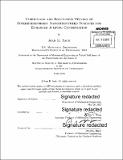Fabrication and robustness testing of superhydrophobic nanostructured surfaces for enhanced jumping condensation
Author(s)
Sack, Jean H. (Jean Hope)
DownloadFull printable version (11.24Mb)
Other Contributors
Massachusetts Institute of Technology. Department of Mechanical Engineering.
Advisor
Evelyn N. Wang.
Terms of use
Metadata
Show full item recordAbstract
Increasing worldwide and domestic demands for power and clean water will require advanced heat transfer materials. Superhydrophobic micro- and nano-structured surfaces which promote a jumping droplet mode of condensation have been shown to enhance heat transfer over conventional film wise condensation surfaces, but limited robustness testing has been reported validating feasibility of industrial implementation. This thesis seeks to quantify the robustness of a variety of nanostructures, substrates and coatings by analyzing contact angle measurements and SEM imaging over the course of accelerated robustness testing. This testing was enabled through the design and construction of three custom-built setups intended to accelerate the onset of failure mechanisms. These setups consist of a flow setup to observe resistance to shear flows from internal condensation steam flow, a droplet impingement setup to test mechanical durability, and an elevated temperature condensation chamber to characterize thermal stability. Methods for fabricating nanostructures were also developed, and scalable zinc oxide nanowires (ZnO) and copper oxide nanoblades (CuO) were used. CuO nanoblades were etched into copper, and ZnO nanowires were grown on silicon, low carbon steel, titanium, stainless steel, and electroplated nickel. Hydrophobic coatings tested on these surfaces included stearic acid and two polymer coatings: P2i (40nm) and Semblant. Observed failure mechanisms were coating degradation and poor nanostructure adhesion. Nanostrucure adhesion issues were observed as delamination of ZnO nanowires primarily on stainless steel substrates. Adhesion was improved through the addition of an electroplated nickel layer before nanowire growth, but delamination was still observed. This is likely the result a large mismatch in coefficient of thermal expansion between the ZnO nanowires and the substrate. The etched CuO nanostructures with a fluorinated polymer coating (P2i) showed very little change in performance throughout robustness testing. Characterization methods included contact angle measurements to monitor surface uniformity and durability, and scanning electron microscope (SEM) imaging to observe nanostructure degradation and delamination. Preliminary work was also done to functionalize the inside of tubes and design a dedicated test setup to characterize heat transfer measurements for internal jumping condensation. This setup will allow for extended robustness testing over a range of temperatures, pressures, and geometries, and give baseline heat flux values for comparison with dropwise or filmwise internal condensation. While ZnO nanowires still require additional testing and development, CuO nanoblades are good candidates for internal heat transfer measurements and scaled up robustness testing. Assuming this characterization confirms the expected benefits of jumping condensation from increased droplet removal and nucleation density, this technology has the potential to significantly improve power plant efficiency and output worldwide.
Description
Thesis: S.M., Massachusetts Institute of Technology, Department of Mechanical Engineering, 2015. "June 2015." Cataloged from PDF version of thesis. Includes bibliographical references (pages 53-58).
Date issued
2015Department
Massachusetts Institute of Technology. Department of Mechanical EngineeringPublisher
Massachusetts Institute of Technology
Keywords
Mechanical Engineering.